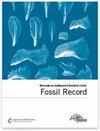下载PDF
{"title":"东非上新世-更新世食蚁兽(哺乳目,管齿目)","authors":"Thomas Lehmann","doi":"10.1002/mmng.200800003","DOIUrl":null,"url":null,"abstract":"<p>The Tubulidentata are unique among mammals for being the only order represented nowadays by a single living species, <i>Orycteropus afer</i>: the aardvark. Nevertheless, it is one of the least studied mammalian orders. Aardvarks are currently distributed all over sub-Saharan Africa, but the fossil record extends their spatial range to Europe and Asia. The earliest known Tubulidentata are ca. 20 million years old. About 14 species and three to four genera have been recognised so far, but since the late Pliocene, aardvarks have only been represented by a single genus and are restricted to Africa. The extant aardvark is the only species of Tubulidentata with a large distribution area, i.e. the African continent. There are three known Plio-Pleistocene African species of aardvark: <i>Orycteropus afer</i> (Pallas, 1766), <i>O. crassidens</i> MacInnes, 1956, and <i>O. djourabensis</i> Lehmann et al., 2004. Fossils of these species have been discovered in North-Africa, Kenya, and Chad respectively. The present study is focused on the aardvark material found in the Plio-Pleistocene of East Africa (Ethiopia, Kenya). New specimens from Asa Issie (Ethiopia) and East Turkana (Kenya) are described, and published ones are re-examined in the light of the latest discoveries. This study demonstrates that Kenyan specimens identified as <i>O. crassidens</i> are in fact representatives of the Chadian <i>O. djourabensis</i>. Moreover, additional material from Ethiopia and Kenya shows a close relationship with the latter species too. The presence of specimens of <i>O. djourabensis</i> in Chad and in Kenya during the Plio-Pleistocene implies that this taxon is the oldest-known species of aardvark to have experienced a continental dispersal. It also shows that Tubulidentates were able to cross Africa from east-west during Plio-Pleistocene times, despite the presence of the Rift Valley. It is however not possible to infer the centre of origin of <i>O. djourabensis</i>. Finally, this study suggests that two species of aardvark might have co-existed in Kenya during the early Pleistocene. (© 2008 WILEY-VCH Verlag GmbH & Co. KGaA, Weinheim)</p>","PeriodicalId":55147,"journal":{"name":"Fossil Record","volume":"11 2","pages":"67-81"},"PeriodicalIF":2.1000,"publicationDate":"2008-09-18","publicationTypes":"Journal Article","fieldsOfStudy":null,"isOpenAccess":false,"openAccessPdf":"https://sci-hub-pdf.com/10.1002/mmng.200800003","citationCount":"7","resultStr":"{\"title\":\"Plio-Pleistocene aardvarks (Mammalia, Tubulidentata) from East Africa\",\"authors\":\"Thomas Lehmann\",\"doi\":\"10.1002/mmng.200800003\",\"DOIUrl\":null,\"url\":null,\"abstract\":\"<p>The Tubulidentata are unique among mammals for being the only order represented nowadays by a single living species, <i>Orycteropus afer</i>: the aardvark. Nevertheless, it is one of the least studied mammalian orders. Aardvarks are currently distributed all over sub-Saharan Africa, but the fossil record extends their spatial range to Europe and Asia. The earliest known Tubulidentata are ca. 20 million years old. About 14 species and three to four genera have been recognised so far, but since the late Pliocene, aardvarks have only been represented by a single genus and are restricted to Africa. The extant aardvark is the only species of Tubulidentata with a large distribution area, i.e. the African continent. There are three known Plio-Pleistocene African species of aardvark: <i>Orycteropus afer</i> (Pallas, 1766), <i>O. crassidens</i> MacInnes, 1956, and <i>O. djourabensis</i> Lehmann et al., 2004. Fossils of these species have been discovered in North-Africa, Kenya, and Chad respectively. The present study is focused on the aardvark material found in the Plio-Pleistocene of East Africa (Ethiopia, Kenya). New specimens from Asa Issie (Ethiopia) and East Turkana (Kenya) are described, and published ones are re-examined in the light of the latest discoveries. This study demonstrates that Kenyan specimens identified as <i>O. crassidens</i> are in fact representatives of the Chadian <i>O. djourabensis</i>. Moreover, additional material from Ethiopia and Kenya shows a close relationship with the latter species too. The presence of specimens of <i>O. djourabensis</i> in Chad and in Kenya during the Plio-Pleistocene implies that this taxon is the oldest-known species of aardvark to have experienced a continental dispersal. It also shows that Tubulidentates were able to cross Africa from east-west during Plio-Pleistocene times, despite the presence of the Rift Valley. It is however not possible to infer the centre of origin of <i>O. djourabensis</i>. Finally, this study suggests that two species of aardvark might have co-existed in Kenya during the early Pleistocene. (© 2008 WILEY-VCH Verlag GmbH & Co. KGaA, Weinheim)</p>\",\"PeriodicalId\":55147,\"journal\":{\"name\":\"Fossil Record\",\"volume\":\"11 2\",\"pages\":\"67-81\"},\"PeriodicalIF\":2.1000,\"publicationDate\":\"2008-09-18\",\"publicationTypes\":\"Journal Article\",\"fieldsOfStudy\":null,\"isOpenAccess\":false,\"openAccessPdf\":\"https://sci-hub-pdf.com/10.1002/mmng.200800003\",\"citationCount\":\"7\",\"resultStr\":null,\"platform\":\"Semanticscholar\",\"paperid\":null,\"PeriodicalName\":\"Fossil Record\",\"FirstCategoryId\":\"89\",\"ListUrlMain\":\"https://onlinelibrary.wiley.com/doi/10.1002/mmng.200800003\",\"RegionNum\":4,\"RegionCategory\":\"地球科学\",\"ArticlePicture\":[],\"TitleCN\":null,\"AbstractTextCN\":null,\"PMCID\":null,\"EPubDate\":\"\",\"PubModel\":\"\",\"JCR\":\"Q3\",\"JCRName\":\"Earth and Planetary Sciences\",\"Score\":null,\"Total\":0}","platform":"Semanticscholar","paperid":null,"PeriodicalName":"Fossil Record","FirstCategoryId":"89","ListUrlMain":"https://onlinelibrary.wiley.com/doi/10.1002/mmng.200800003","RegionNum":4,"RegionCategory":"地球科学","ArticlePicture":[],"TitleCN":null,"AbstractTextCN":null,"PMCID":null,"EPubDate":"","PubModel":"","JCR":"Q3","JCRName":"Earth and Planetary Sciences","Score":null,"Total":0}
引用次数: 7
引用
批量引用

 求助内容:
求助内容: 应助结果提醒方式:
应助结果提醒方式:


